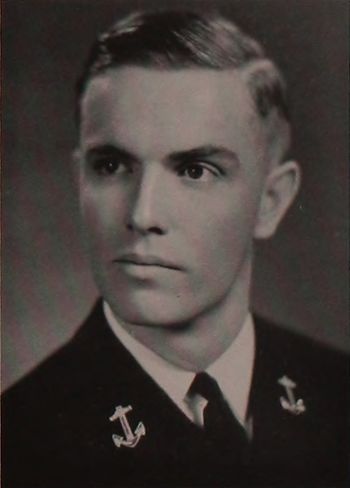JOHN J. KIRWIN, LT, USN
John Kirwin '41
Lucky Bag
From the 1941 Lucky Bag:
JOHN JOSEPH KIRWIN
Newport, Rhode Island
John came to Annapolis from the town he has so romantically titled the "City by the Sea" (otherwise known to us as Newport). He was already familiar with the Navy through his many contacts in Newport, and he carefully built his foundation for entering the Naval Academy; after a little engineering difficulty in regulating his temperature and pressure to please the Medical Board, he finally achieved his goal.
Through his good nature and sense of humor Jack has made friends with practically everyone. In the meantime, he has also acquired a record number of nick-names, among them J.J., Jig, J-square, Pete, Double-Jig, and even Jack. His classical observation on the whole academic course is that "it was all fruit."
We shall never be able to forget Jack's ability to tell sea stories with the best of them, and shall look forward to that time "when two or three shall meet, and old tales be retold," when we can hear him start the ball rolling with "Remember the time back at the Academy…"
Boat Club.
The Class of 1941 was the first of the wartime-accelerated classes, graduating in February 1941.

JOHN JOSEPH KIRWIN
Newport, Rhode Island
John came to Annapolis from the town he has so romantically titled the "City by the Sea" (otherwise known to us as Newport). He was already familiar with the Navy through his many contacts in Newport, and he carefully built his foundation for entering the Naval Academy; after a little engineering difficulty in regulating his temperature and pressure to please the Medical Board, he finally achieved his goal.
Through his good nature and sense of humor Jack has made friends with practically everyone. In the meantime, he has also acquired a record number of nick-names, among them J.J., Jig, J-square, Pete, Double-Jig, and even Jack. His classical observation on the whole academic course is that "it was all fruit."
We shall never be able to forget Jack's ability to tell sea stories with the best of them, and shall look forward to that time "when two or three shall meet, and old tales be retold," when we can hear him start the ball rolling with "Remember the time back at the Academy…"
Boat Club.
The Class of 1941 was the first of the wartime-accelerated classes, graduating in February 1941.
Loss
John was one of 197 officers and crew lost when USS Savannah (CL 42) was struck by a German radio-controlled Fritz X glide-bomb on September 11, 1943 while providing gunfire support for the landings at Salerno, Italy.
Other Information
From Wikipedia:
John Joseph Kirwin was born in Newport, Rhode Island, on 4 July 1918. He enlisted in the United States Naval Reserve on 11 December 1935. He was appointed midshipman on 11 August 1937, and commissioned as an ensign on 7 February 1941, reporting for duty aboard light cruiser USS Savannah (CL-42).
During World War II, Kirwin was appointed Lieutenant, junior grade, on 16 June 1942, and saw action aboard Savannah in the Battle of the Atlantic and in Operation Torch, the Allied invasion of North Africa. He was promoted to Lieutenant on 1 December 1942, and saw further combat aboard Savannah in Operation Husky, the Allied invasion of Sicily.
Savannah then supported Operation Avalanche, the Allied invasion of mainland Italy at Salerno. On 11 September 1943, while bombarding German shore defenses in Salerno Bay, Savannah was among cruisers which came under heavy German aerial attack. The cruisers and British Supermarine Spitfire fighters drove off nearly 60 German bombers before a Dornier Do 217K-2 bomber hit Savannah with a Fritz X radio-controlled, armor-piercing guided bomb. It pierced the armored roof of the No. 3 gun turret immediately in front of the ship's bridge, passed through three decks into the lower shell-handling room, and exploded there, blowing a gaping hole in the ship's bottom, and tearing open a seam in the ship's port side. For 30 minutes, secondary explosions in the gun room hampered fire-fighting efforts.
Kirwin was at his battle station as turret officer in No. 3 turret when the bomb struck. He remained behind in the turret to supervise the evacuation of as many men as possible, was overcome by heat and toxic smoke, and died at his station.
His parents were listed as next of kin.
John has a memory marker in Rhode Island.
From Hall of Valor:
The President of the United States of America takes pride in presenting the Navy Cross (Posthumously) to Lieutenant John J. Kirwin (NSN: 0-100292), United States Navy, for extraordinary heroism and distinguished service in the line of his profession as a Turret Officer of the Light Cruiser U.S.S. SAVANNAH (CL-42), while that vessel was stationed in the Gulf of Salerno supporting our landings during the amphibious invasion of Italy on 11 September 1943. When the detonation of an enemy bomb inflicted heavy casualties, set off numerous fires and filled the turret with dense smoke and toxic gases, Lieutenant Kirwin promptly ordered the area abandoned and, despite the imminent danger of magazine explosion, stood by his station in the turret booth. With full knowledge of the serious hazards involved and with complete disregard for his own personal safety, he calmly supervised evacuation and deliberately remained behind to aid in saving the lives of as many of his command as possible when he might easily have escaped. As a result of his heroic conduct and fearless devotion to duty, Lieutenant Kirwin eventually succumbed in the stricken booth, gallantly sacrificing his own life in order that his men might live.
General Orders: Bureau of Naval Personnel Information Bulletin No. 325 (April 1944)
Action Date: 11-Sep-43
Service: Navy
Rank: Lieutenant
Company: Turret Officer
Division: U.S.S. Savannah (CL-42)
Namesake
USS Kirwin (APD 90) was named in John's honor, and was sponsored by his mother.
The "Register of Commissioned and Warrant Officers of the United States Navy and Marine Corps" was published annually from 1815 through at least the 1970s; it provided rank, command or station, and occasionally billet until the beginning of World War II when command/station was no longer included. Scanned copies were reviewed and data entered from the mid-1840s through 1922, when more-frequent Navy Directories were available.
The Navy Directory was a publication that provided information on the command, billet, and rank of every active and retired naval officer. Single editions have been found online from January 1915 and March 1918, and then from three to six editions per year from 1923 through 1940; the final edition is from April 1941.
The entries in both series of documents are sometimes cryptic and confusing. They are often inconsistent, even within an edition, with the name of commands; this is especially true for aviation squadrons in the 1920s and early 1930s.
Alumni listed at the same command may or may not have had significant interactions; they could have shared a stateroom or workspace, stood many hours of watch together, or, especially at the larger commands, they might not have known each other at all. The information provides the opportunity to draw connections that are otherwise invisible, though, and gives a fuller view of the professional experiences of these alumni in Memorial Hall.
April 1941
Memorial Hall Error
John's middle name is incorrectly spelled "JOSHEPH" on the killed in action panel.

The "category" links below lead to lists of related Honorees; use them to explore further the service and sacrifice of alumni in Memorial Hall.